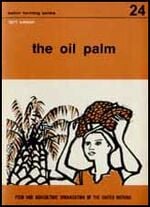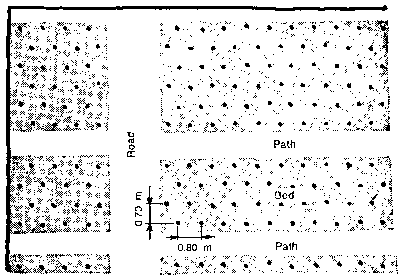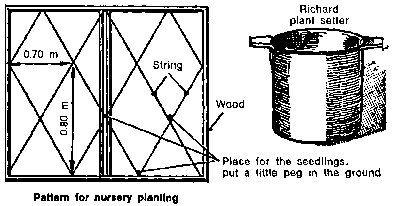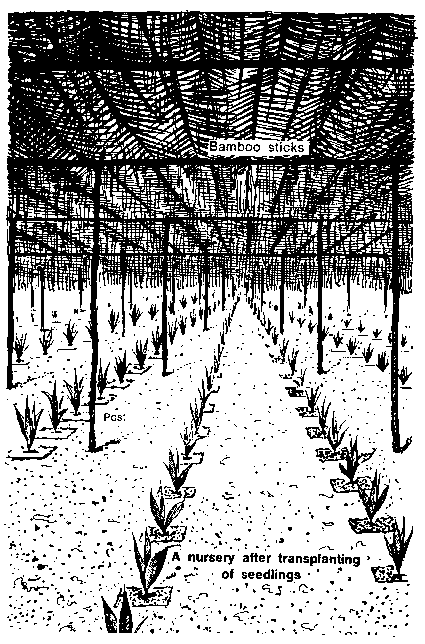20. It is difficult for a grower to make the seeds of oil palms germinate.
Growers buy young seedlings which already have four or five leaves. Seedlings can be bought from research stations or extension services.
The young seedlings are then put into a nursery.
The nursery is a small plot in which the young oil palms develop.
When the oil palms are big enough, they are planted out in the palm grove.
Nurseries cause a lot of expense and need much care.
It would be very expensive for one grower alone to make a nursery; it is better to make the nursery jointly with other growers.
It is very important to make a success of the nursery, so as to get fine young plants.
A seedling that has not grown well in the nursery will make a poor oil palm.
To have fine seedlings in the nursery you must:
- choose a good site and prepare it well,
- choose the finest seedlings,
- water them, protect them against erosion and weeds, give them fertilizers, protect them against insects and diseases.
How to make a nursery[edit | edit source]
21. Choosing the site
The soil should be fairly rich and well prepared.
It is best to clear a bit of forest for the nursery plot. If you clear a forest site for the nursery pull out all the trees and burn them. Burning all the wood helps to control certain diseases which might attack the roots of the oil palms, and it also makes the soil more fertile. Spread the ashes all over the plot.
If you put the nursery on a field which is already cultivated, pull up all the old crops: cocoa trees, coffee trees, oil palms.
Burn all the wood.
When the site is well cleared, it needs deep tilling. You should till 40 centimetres deep with a hoe or a tractor.
To improve the soil structure, you can then sow a green-manure crop, like Centrosema or Crotalaria. When these crops have grown, work them into the soil by tilling again.
Then apply fertilizers: 500 kilogrammes of dicalcium phosphate per hectare.
Layout of paths and nursery beds[edit | edit source]
22. Nursery bed is the name for the strip of soil where the oil palm seedlings are planted. It is best to make the nursery on flat ground. But, if the ground slopes, the beds must lie across the slope.
The beds should be 45 metres long and 3.5 metres wide. The soil of the beds should be well worked to make it quite flat. After that, apply a dressing of fertilizer. For instance, at La Me, Ivory Coast, 250 kilogrammes of 10: 10: 20 fertilizer are applied per hectare.
Apply a dressing of fertilizer
23. Making holes for seedlings and transplanting
To know where to make the holes for your seedlings, make a pattern.
At the places where you have put your little pegs, make a hole with a Richard plant setter.
Then put a seedling with its ball of earth into each hole.
You must give the seedlings a lot of water. But do not water when it is hot; it is best to water in the evening and the morning.
To protect the soil against erosion, mulch it.
Cover the ground with herbage or cluster residues. Leave a ring of 20 centimetres of unmulched ground around each seedling.
If you mulch with cluster residues, put them down only three months after transplanting, so that the insects do not attack the young leaves.
If you mulch with herbage, you must replace the herbage when it rots. Then hoe the soil.
If you cannot get enough water for the seedlings, transplant them into the nursery at the beginning of the rainy season.
At the end of the rainy season, the seedlings will be strong enough to get through the drought.
Pattern for nursery planting
Putting up shelters[edit | edit source]
24. In certain regions shelter has to be put up over the nursery.
This protects the young seedlings from a disease called blast.
These shelters are made with posts and bamboo sticks.
To make the shelters more solid, put two posts together.
The posts should be 2.5 metres high. The bamboo sticks are tied to the posts with lianas.
Finally, put palm fronds over the bamboo sticks.
In Benin, shade for the young oil palms is provided by planting castor-oil plants in the nursery.
It you make a shelter, you need not mulch, but you must hoe very often.
Get rid of all the weeds, and always keep the soil loose.
Three months after transplanting, if the seedlings have grown well, apply monthly to each plant 15 to 20 grammes of a mixture of ammonium sulfate and potassium chloride.
Spread the fertilizer mixture in a ring 10 centimetres from the seedling and water.
Hoe to work the fertilizer into the ground.
The seedlings stay in the nursery for about 1 year. You must plan, therefore, to make the nursery about 1 year before you want to plant your palm grove.
A nursery after transplating of seedings



